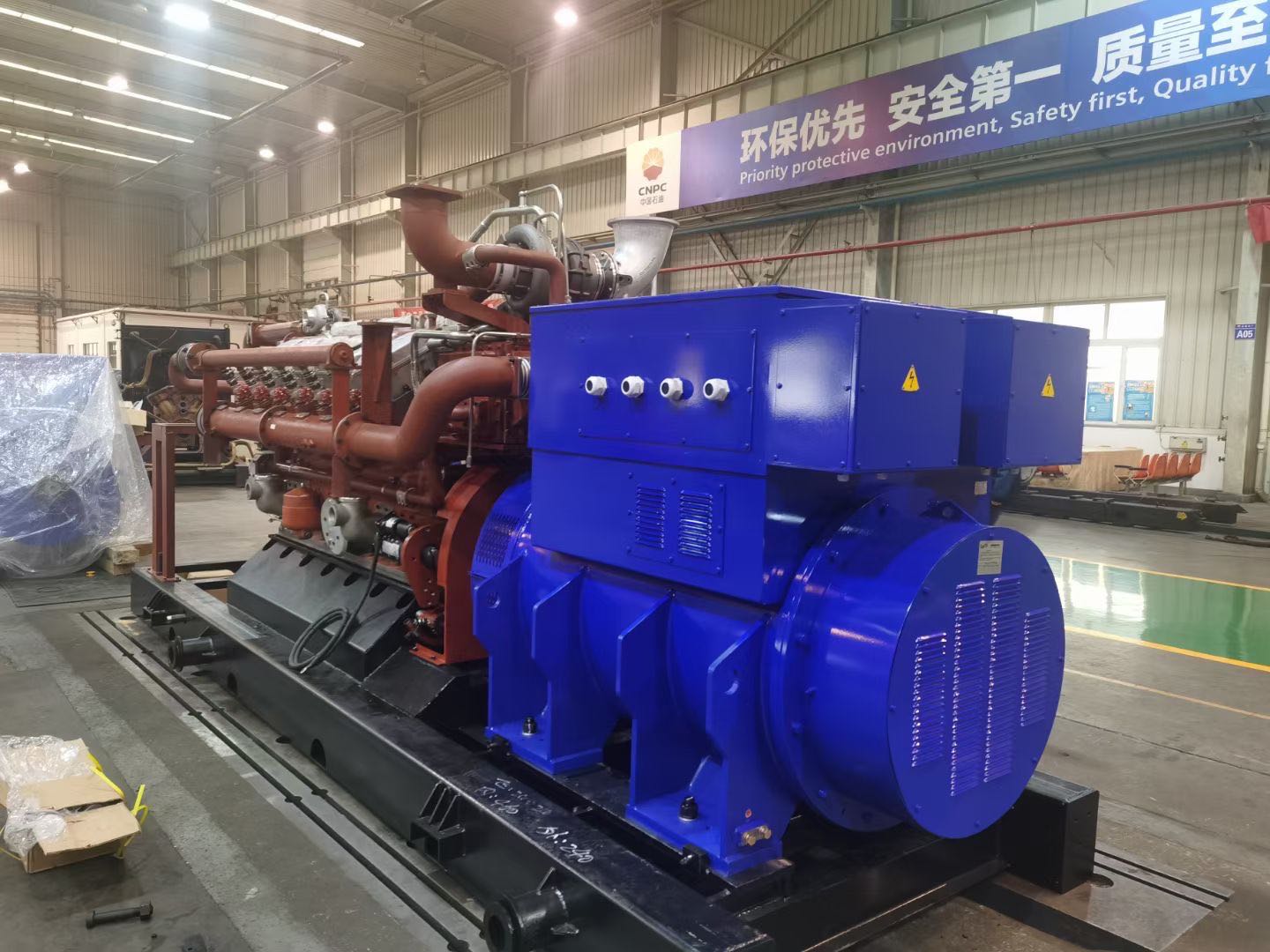粉尘等固体颗粒物对燃气内燃发电机组的影响,主要在于造成过滤器堵塞、进气量不足和压力降低等。在发动机气缸内部会造成缸壁和活塞磨损,同时也会污染润滑油,进而造成其他部件如滑动轴承的磨损,影响机组的正常运行。发动机燃气进气阀组自带的过滤器仅用于保护系统不受颗粒物损坏,不能作为工作负荷过滤器。用户应在燃气管路设置工作负荷过滤器,且过滤器在颗粒直径大于3 μm 时,分离率必须达到 99.99%或以上。
The impact of solid particles such as dust on gas internal combustion generator sets mainly lies in causing filter blockage, insufficient air intake, and pressure reduction. Inside the engine cylinder, it can cause wear on the cylinder wall and piston, as well as contaminate the lubricating oil, resulting in wear on other components such as sliding bearings and affecting the normal operation of the unit. The built-in filter of the engine gas intake valve group is only used to protect the system from particle damage and cannot be used as a workload filter. Users should install a workload filter in the gas pipeline, and the filter should be installed when the particle diameter is greater than 3 μ At m, the separation rate must reach 99.99% or above.
对于助燃空气,颜巴赫燃气发电机组要求空气中颗粒物含量不高于0.1 mg/Nm3,助燃空气过滤器至少满足EN779 G3等级,且必须确保各类工艺的排放气体(如工业废气、生物过程排放尾气或溶剂)不能进入到发动机助燃空气中,以免影响发动机的运行。
For combustion air, Yanbach gas generator sets require that the particulate matter content in the air should not exceed 0.1 mg/Nm3, and the combustion air filter should at least meet the EN779 G3 level. It is necessary to ensure that the exhaust gases from various processes (such as industrial waste gas, biological process exhaust gas, or solvents) cannot enter the engine combustion air to avoid affecting engine operation.
硫
sulfur
在生物沼气等燃气中常常含有硫化氢等含硫化合物,如果在气缸内燃烧则形成二氧化硫和三氧化硫。由于燃气中含有水分且燃气燃烧也将产生水分,含硫化合物溶于水形成氢硫酸、亚硫酸和硫酸,这些酸性物质会对发动机金属部件产生腐蚀。含硫化合物溶于机油中也会使机油酸化,降低机油的润滑能力,缩短机油使用寿命,并且对发动机内需要通过机油进行润滑的部件产生腐蚀性影响,例如轴瓦、凸轮摇臂机构等。此外,含硫化合物也会对火花塞的金属电极产生腐蚀,缩短火花塞使用寿命。
Gases such as biogas often contain sulfur containing compounds such as hydrogen sulfide. If burned in the cylinder, sulfur dioxide and sulfur trioxide are formed. Due to the presence of moisture in gas and the generation of moisture during combustion, sulfur-containing compounds dissolve in water to form hydrosulfuric acid, sulfite, and sulfuric acid, which can corrode engine metal components. Sulfur-containing compounds dissolved in engine oil can also acidify the oil, reduce its lubrication ability, shorten its service life, and have corrosive effects on components that need to be lubricated through oil in the engine, such as bearing shells, cam rocker mechanisms, etc. In addition, sulfur compounds can also corrode the metal electrodes of spark plugs, shortening their service life.
燃气内燃发电机组对于燃气含硫量的具体要求跟机组型号以及燃气甲烷浓度等都有关系,一般来说进入发动机的燃气中含硫总量应低于300 mg/Nm3。此外,带预燃室的机型通常有额外的要求。如果有带催化剂的尾气处理设备,还需考虑催化剂对硫含量的要求。
The specific requirements for gas sulfur content in gas internal combustion generator sets are related to the unit model and gas methane concentration. Generally, the total sulfur content in the gas entering the engine should be less than 300 mg/Nm3. In addition, models with pre combustion chambers typically have additional requirements. If there is a tail gas treatment equipment with a catalyst, it is also necessary to consider the catalyst's requirements for sulfur content.
在热电联供系统中,发动机尾气常通过烟气热水换热器进行热交换以回收尾气余热。如果烟气温度降到硫氧化物(SOx)的酸露点以下,则会对换热器产生腐蚀。图1为硫氧化物的浓度与酸露点的曲线。
In a cogeneration system, engine exhaust is often heat exchanged through a flue gas hot water heat exchanger to recover exhaust heat. If the flue gas temperature drops below the acid dew point of sulfur oxides (SOx), it will cause corrosion to the heat exchanger. Figure 1 shows the curve between the concentration of sulfur oxides and the acid dew point.
挥发性有机硅化合物(VOSC)
Volatile Organic Silicon Compounds (VOSC)

在生物沼气、垃圾填埋气中常常出现有机硅化合物,并且以硅氧烷分解物的形式存在,其特性是可燃、易挥发。这种物质在发动机中燃烧后会产生氧化硅,久而久之会形成沉积物覆盖在发动机气缸盖表面,这会增加发动机的维护工作。如果发电系统配置了催化氧化剂尾气处理装置,此类杂质还会使催化剂失效。
Organic silicon compounds often appear in biogas and landfill gas, and exist in the form of siloxane decomposition products, which are flammable and volatile. After combustion in the engine, this substance will produce silicon oxide, which over time will form sediment covering the surface of the engine cylinder head, which will increase the maintenance work of the engine. If the power generation system is equipped with a catalytic oxidant tail gas treatment device, such impurities can also cause catalyst failure.
由于挥发性可氧化硅化合物的波动性,分析其在燃气中的含量较为困难。因此,我们可以对机油进行分析,根据发电机组制造商所提供的检测要求和计算公式,通过在一定运行小时内进行两次机油检测,对机油中硅总量进行分析计算特征值,以确定是否满足机组正常运行的要求。
Due to the volatility of volatile oxidizable silicon compounds, it is difficult to analyze their content in gas. Therefore, we can analyze the oil and, based on the testing requirements and calculation formulas provided by the generator set manufacturer, conduct two oil tests within a certain operating hour to analyze and calculate the characteristic values of the total silicon content in the oil, in order to determine whether it meets the requirements for normal operation of the unit.
焦油
Tar
在冷却至低于露点的情况下,如果在燃气或者混合气中析出固态、液态或者高黏度产物形式的碳氢化合物,则将这类冷凝或者升华产物称为焦油。由于不同的运行温度和热化学反应过程,生物质热解和气化过程中会产生成百上千种不同类别的焦油。通常,此类碳氢化合物在低温遇冷时凝结成液态,会堵塞进气系统、涡轮增压器叶片和中冷器等。
If hydrocarbons in the form of solid, liquid, or high viscosity products are precipitated in the gas or mixture when cooled to below the dew point, such condensation or sublimation products are called tar. Due to different operating temperatures and thermochemical reaction processes, hundreds or thousands of different types of tar are produced during biomass pyrolysis and gasification. Usually, such hydrocarbons condense into liquid when they are cooled at low temperature, which will block the intake system, turbocharger blades, intercooler, etc.
很难用简单的冷凝方法完全去除焦油,因此对于含有焦油的燃气,需要在燃气进气阀组管路上安装加热装置,同时避免温度较低的助燃空气与含有此类碳氢化合物的燃气混合。对生物质热解气进行预处理后,对其中焦油的露点进行分析是一个行之有效的方法。燃气中焦油露点一般应低于燃气露点5°C以上,这样才能避免焦油进入燃气接触的部件内。以颜巴赫燃气发电机组为例,机组对燃气进气温度的范围要求是10 - 40°C。
It is difficult to completely remove tar using a simple condensation method. Therefore, for gas containing tar, it is necessary to install a heating device on the gas inlet valve group pipeline, while avoiding the mixing of low-temperature combustion air with gas containing such hydrocarbons. Analyzing the dew point of tar in biomass pyrolysis gas after pre-treatment is an effective method. The dew point of tar in gas should generally be 5 ° C or above lower than the dew point of gas, in order to prevent tar from entering components in contact with gas. Taking Yanbach gas generator unit as an example, the range of gas inlet temperature required by the unit is 10-40 ° C.
通过上述分析可以发现,燃气中几种常见杂质将影响燃气内燃发电机组的正常运行。如果使用杂质超标的燃气,某些情况下发电机组也许不会立即发生运行指标衰减、故障停机等显性问题。但这类杂质对发电机组带来的危害将逐渐累积,并对机组的运行效果,正常维护间隙甚至使用寿命产生非常深远的负面影响。
Through the above analysis, it can be found that several common impurities in gas will affect the normal operation of gas internal combustion power generation units. If gas with excessive impurities is used, in some cases, the generator unit may not immediately experience obvious problems such as operational indicator attenuation and fault shutdown. However, the harm caused by such impurities to the power generation unit will gradually accumulate, and have a very profound negative impact on the operation effect, normal maintenance clearance, and even service life of the unit.
感谢您的阅读,此文的文章来源:
热解气发电机组更多的内容和问题请点击:
我们会继续努力的为您提供服务,感谢您的支持!
Thank you for reading. The source of this article is: Thermal decomposition gas generator set. For more information and questions, please click on: We will continue to work hard to provide you with services. Thank you for your support!
 联系 - 热线
联系 - 热线

 联系 - 热线
联系 - 热线


